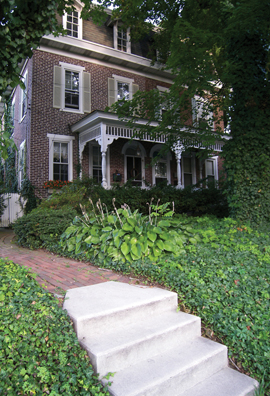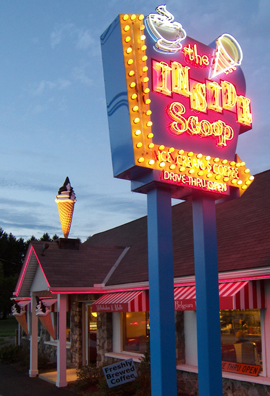Coopersburg
By Kathryn Finegan Clark
Coopersburg’s birth and growth are carved dramatically on the borough seal which features three important symbols: seven stars, a cow and a wheel.
The stars commemorate the name of the settlement’s first hotel erected between 1745 and 1750 along what was to become Bethlehem Pike. That road was opened in 1755 and ran from Philadelphia to Bethlehem.
The wheel denotes the importance of transportation to the little town; from crude pioneer wagons crossing an early turnpike to the horseless carriages that were important to the borough’s economy in the early 20th Century.
The cow is a symbol for the town’s farming origins as well as the famous cattle auctions that put it on the map in the early 1900s.
The seal is a testament to the past, but Coopersburg is not a town that disappeared into yesterday when a new road was built.
While it is one of those Lehigh County villages shoved off the main track when Route 309 was constructed, it is a vibrant, busy, but still quiet town — and the people who live there love it that way.
Much of the borough is wrapped around busy Route 309 which slices through its eastern half. Even though the thoroughfare, which doubles as Third Street, buzzes with heavy traffic, the noise seems to have little effect on the village atmosphere. Route 309, of course, is lined with commercial enterprises but the areas beyond on both sides are residential. The Borough of Coopersburg is part of the Southern Lehigh School District and is surrounded by Upper Saucon Township.
 The Southern Lehigh Living Memorial Community Park east of Route 309, is shared by borough and township, and Coopersburg Municipal Pool abuts Tumblebrook, Upper Saucon’s municipal golf course, filling out a nice stretch of open space. The park is the site of ball games, automobile shows, and the Coopersburg Community Day celebration. Last September, the 18th annual event drew a crowd of 10,000.
The Southern Lehigh Living Memorial Community Park east of Route 309, is shared by borough and township, and Coopersburg Municipal Pool abuts Tumblebrook, Upper Saucon’s municipal golf course, filling out a nice stretch of open space. The park is the site of ball games, automobile shows, and the Coopersburg Community Day celebration. Last September, the 18th annual event drew a crowd of 10,000.
Coopersburg is alive and well, a thriving square mile of a town that is as self-contained as it is lovely. With the arrival of the North Pennsylvania Railroad in the 1850s, the town exploded in a flurry of building both of new homes as well as new businesses. Connecting Philadelphia and Bethlehem, the railroad reached Coopersburg in 1856, a full century after the Bethlehem Pike was opened.
Many of the homes built around the railroad comprise the Coopersburg Historic District which was placed on the National Register of Historic Places in 1980. The district actually covers two areas, one along Main Street, and the second newer area bordering Station Avenue. The two include about 175 buildings erected before 1930.
But the town’s roots go much deeper than that. It was settled as early as 1730 along an old Indian trail that was to become Bethlehem Pike, stretching from the Lehigh Mountains to the Delaware River.
At the time it was called Freytown in honor of a local tavern owner and judge. When it was incorporated in 1879, its name had already been changed to Coopersburg after Judge Peter Cooper.
One of the earliest villages in Lehigh County, it was established by Mennonites along the south branch of the Saucon Creek. Early families were named Bachman, Frey, Landis and Cooper.
The present Saucon Mennonite Church, outside the borough, is situated where a log structure, which served as both church and school, was erected in 1738. Classes were conducted in German and a “taught-fee” was three to five cents per head per day.
Other churches followed: St. Paul’s Blue Church in 1739, and eventually, three union churches, serving both Lutheran and Reformed congregations, a common practice in the colony.
Between 1745 and 1750, George Bachman, who owned 300 acres of what is now the borough, built a hotel named Der Siebenstem (The Seven Stars). That brought the inevitable barn, store and houses, all constructed of logs and forming a small community to serve the drivers and passengers of wagons and stage coaches stopping at the hotel.
The settlers were mostly German farmers and craftsman and for many years the town served an agricultural community. The Seven Stars was later taken over by Daniel Cooper who replaced it with the Eagle Hotel in 1829, and the town was renamed in honor of his son in 1879.
The Cooper family in general had much to do with the prosperity of the town that bears its name. Tilghman S. Cooper bred pure bred Jersey cattle at his estate on Main Street, between Cherry and Linden.
 For the first 30 years of the 20th Century, Cooper conducted Memorial Day cattle auctions at his farm/estate in the borough. Thousands of dairymen from all over the country were drawn to his Linden Grove Pavilion each year for the auction, a major event for the industry. The Great Depression brought an end to the auctions, but the pavilion, built so sales could continue on rainy days, remains and is listed on the National Register of Historic Places.
For the first 30 years of the 20th Century, Cooper conducted Memorial Day cattle auctions at his farm/estate in the borough. Thousands of dairymen from all over the country were drawn to his Linden Grove Pavilion each year for the auction, a major event for the industry. The Great Depression brought an end to the auctions, but the pavilion, built so sales could continue on rainy days, remains and is listed on the National Register of Historic Places.
One of the prized possessions of the Coopersburg Historical Society Museum, which occupies the second floor of the handsome borough hall, is a copper cow weather vane rescued from the top of the pavilion. Another of the many attractions at the museum is “Bent Plane,” a piece of black granite sculpted by Victor Riu, an Italian artist who settled in Coopersburg. His work can be seen throughout the country.
Cliff Benner, who heads the Coopersburg Historical Society, and his wife, Lorraine, are largely responsible for maintaining the museum’s collection.
It is an impressive museum for a small town and includes items such as a Civil War saber, military uniforms, vintage clothing, an old telephone and a flapper wedding dress worn by one of the Cooper brides.
The small town has also turned out a varied and interesting cast of characters. Sports figures include Chuck Bednarik, a former Philadelphia Eagle and a member of the Professional Football Hall of Fame, (see “Local Color” in this issue of Marketplace for more on Bednarik) and Jimmie Schaffer, a baseball catcher with an eight-year career in the major leagues. He played for the Philadelphia Phillies and other National and American League teams in the 1960s.
Other natives are author John Grogan, who wrote the best-seller, Marley and Me, and Mike Portnoy, drummer for Dream Theater and a member of the Modern Drummers Hall of Fame.
Coopersburg is that kind of wonderful All-American town.
Kathryn Finegan Clark, a freelance journalist and winner of a National Press Club award and state and regional prizes, has been writing feature articles for Lehigh Valley Marketplace for several years.





